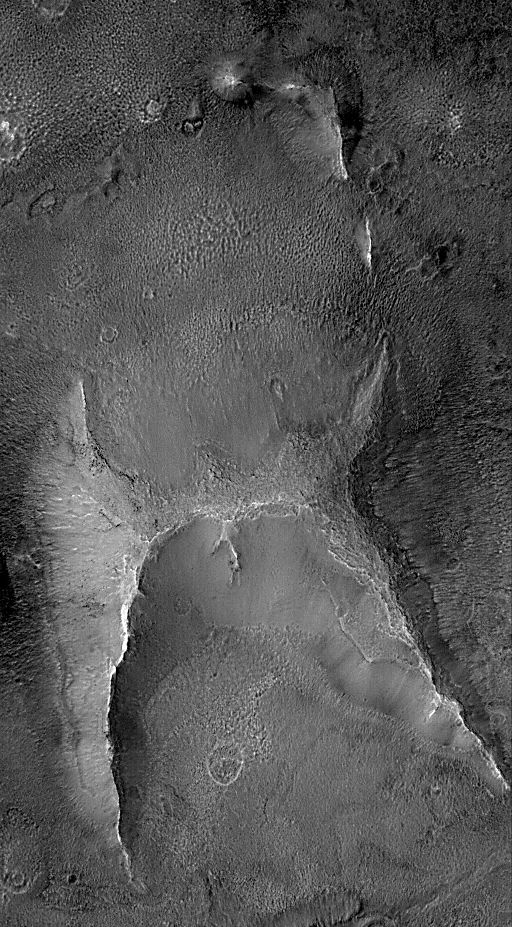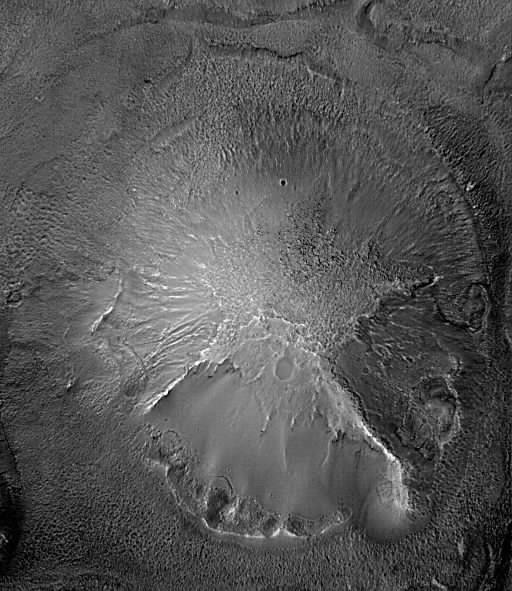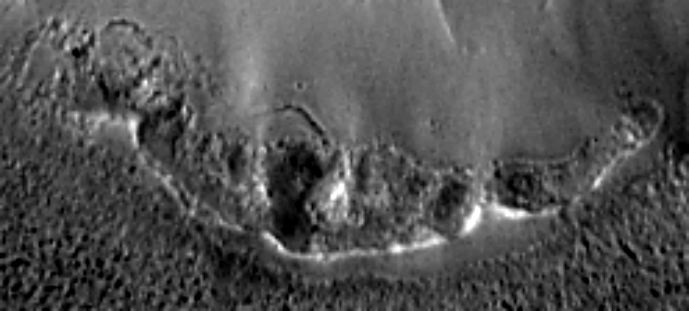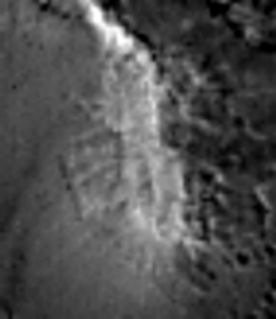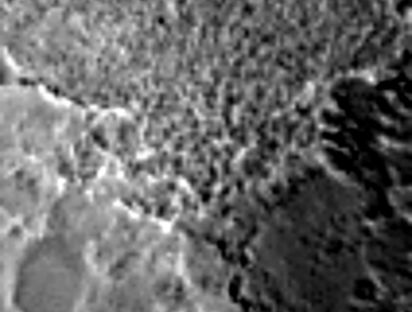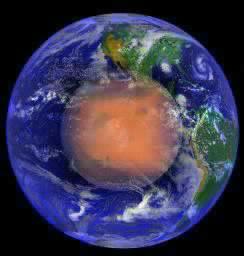 Cydonia Quest C Image Enhancements C MGS's New Arcologies
The January 2001 Cydonia image releases included one image strip, M19-00850, that shot off the northern edge of the context map supplied by MSSS, (click next "stargate" to access image µµµ). As this image was far to the North of the "monuments" area and traversed featureless looking Cydonian plain, I did not bother to download the GIF file for it. More fool me. In mid May I received an e-mail from Keith Laney with some links to pages on his web-site. One of these pages contained a picture of a large, domed hill with the kind of walled moat that is observed around many of the hypothetical arcologies in the Cydonia "City".
On downloading MGS image M19-00850 I discovered that it actually contained two possible arcologies. These are shown in the much reduced context picture on the left. Examination of a MGS wide angle context image, that covered both the "monuments" area and the new area of interest, revealed that the hypothetical arcologies in the M19-00850 image were part of a collection of hills 25 miles to the North of the Cydonia "City". For the purposes of Cydonia Quest the northern most of these two proposed arcologies will be dubbed the "Big H" - for obvious reasons. The domed "arcology" will be named the "SuperBowl". This "SuperBowl" is the same size as the "Main Pyramid" within the "City" i.e., about a mile across. Richard Hoagland's arcology theory suggests that the anomalous formations in Cydonia are the ruins of huge, self contained dwellings - essentially towns contained within single buildings. (A more thorough explanation can be found on the introductory page to the Arcology section - click next "stargate" µµµ). The arcology theory proposes that these super buildings contain a great deal of internal hollow space, both below and above the surrounding ground level. Evidence for the artificiality of proposed arcologies rests on looking for anomalous subsidence or exposed artefacts of structural engineering. In the case of the two new "arcologies" all the evidence for artificiality is to be found in the "SuperBowl". However, (given its proximity to the "SuperBowl") the strange shape of the "Big H" can find an explanation in it being a severely collapsed arcology. This would suggest that the ridges that form the "H" shape are underpinned by the main support structure of what was once a faceted arcology. Now that the interior chambers have completely collapsed this main "H" shaped structural skeleton is all that is left for us to see. One interesting feature of the "Big H" is that the top right hand leg of the "H" extends as an intermittent "wall" before ending in a sharp right angled turn. This can be seen more clearly in the full sized portion of the M19-00850 image strip below. (This article continues below this main illustration).
C The Arcology theory confirmed? Although the M19-00850 image strip only seems to have a low resolution of about 20 feet, the image of the "SuperBowl" shows subsidence into anomalous interior chambers in action. In the Arcology section it was proposed that the walled moats seen in the "City" were the result of the sides of hypothetical arcologies collapsing inwards and downwards as interior chambers collapsed. As a result of this the original base of the arcology was left behind as a wall, with an interior moat caused by collapsed underground chambers swallowing up material falling down from higher up the arcology slope. Another feature of this proposed mechanism was that the main support structures were exposed as straight, downward sloping ridge lines as the surface between them sagged inwards. (A fuller explanation of this proposal and possible geological explanations can be found in the arcology studies of the "City's" East Formation µµµ and West Formation µµµ). Looking at the main illustration above we can see that the southern side of the "SuperBowl" has all the features described. It is when we take a close look at the most prominent stretch of walled moating that we see that the process actually is due to the sides of the "SuperBowl" falling into interior hollow spaces - like grain in a silo or sand in an hourglass. In the three times magnified enhancement below, the side of the "Superbowl" can clearly be seen crumbling and sinking into a chain of pits that have opened up. The fissures forming above the moat on the "Superbowl's" slopes show that its sides are land-sliding down, yet instead of debris collecting at the bottom we find massive sink holes. Moreover, if we look at two of the pits on the centre right of the picture we find that they are roughly rectangular with hints of structural features within them. C
C This crucial piece of evidence confirms the Cydonia Quest theory for how the walled moats have been formed in many of the Cydonia "arcologies". Now there may be some weird geological process on Mars that leads to the formation of large hills honeycombed with hollow spaces. However, it is my opinion that it is Richard Hoagland's theory that these anomalous hills are super buildings - arcologies - that gives the simplest explanation for the interior spaces. Despite the quite low level of resolution, other parts of the "SuperBowl" show possible constructional details. The ridge line running to the bottom right of the "SuperBowl" ends in an extension jutting out from the general domed shape. The enhancement below left magnifies this feature by a factor of four. There are many rectilinear elements and hints of honeycombing that can be interpreted as ruined architectural features. If we go to the top of the same ridge line we find that the peak area of the "SuperBowl" is made of a matrix of very large rectangular blocks - and given the level of resolution these blocks are as big as buildings. This matrix is shown in the image on the bottom right. Are these geological, or artificial features? Given the anomalous nature of the "SuperBowl's" moat these are valid questions to ask. C
C There is one other way in which the "Big H" and the "SuperBowl" are similar to the arcologies in the "monuments" area of Cydonia. They have "suburbs". The enlargement below is of nearby features that bear a striking resemblance to the Cydonia "Suburbs" (µµµ) and "Grill" (µµµ) areas. There are also a few poor examples of the infamous "ribs" in the M19-00850 image strip. C
c µ Return to the Enhancements page
|

